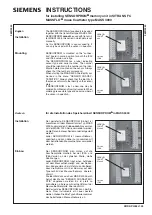
EchoLife OT925-G
User Guide
Tables
Issue 02 (2007-08-30)
Huawei Technologies Proprietary
lxxxv
5.1
Troubleshooting Common Faults
This section describes how to troubleshoot common faults of the OT925-G.
The OT925-G provides status LEDs on the front panel. When a fault occurs, you can locate the fault
through the LED status.
The LINK and AUTH LEDs have two blinking states: quick blinking with a blinking frequency three
times/s and slow blinking with a blinking frequency one time/s.
LED status description and troubleshooting methods
LED
Status
Description and Troubleshooting Method
On
The power supply is normal.
PWR
(Power LED)
Off
The power supply is abnormal.
Check whether the power cable is
connected correctly.
Check whether the power switch is turned
on.
On
Device temperature exceeds the alarm
threshold.
Observe whether the fans rotate through
the heat dissipation net.
Leave more space for heat dissipation
and ventilate the device.
ALM
(System alarm LED)
Off
The device raises no alarm.
LINK
(GPON link LED)
AUTH
(GPON
authentication status
LED)
Quick blinking
Slow blinking
On
Off
The LINK and AUTH LEDs can indicate seven
states of the ONU defined in the G.984.3, as
shown in 0.
Green on
E1 channel is normal without any alarm.
Off
E1 port is idle.
Red on
E1 channel has raised an E1_LOS alarm.
Check whether the E1 cable connector is
well connected to the E1 port.
Check whether the E1 cable is
interrupted.
Check whether the peer device is faulty.
E1 LED
Red blinking
E1 channel has raised a severe alarm,
excluding the E1_LOS alarm.
Contact the vendor for maintenance.







































